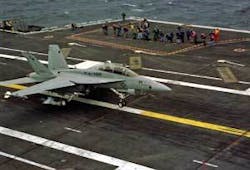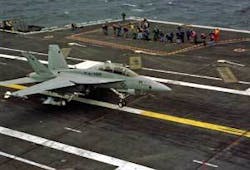DARPA asks Raytheon to develop football-field-size radar for future surveillance airship
By John McHale
EL SEGUNDO, Calif. - Engineers at Raytheon Space and Airborne Systems (SAS) are developing a radar antenna as long as a football field that would weigh less than the 22 players in action during a game. The work is part of an $8 million contract associated with the Integrated Sensor is Structure, or ISIS, program of the U.S. Defense Advanced Research Projects Agency (DARPA) in Arlington, Va.
The goal of the ISIS program is to develop a stratospheric airship-based autonomous unmanned sensor with years of persistence in surveillance and tracking of aircraft and ground forces. DARPA officials say the ISIS airship will have the ability to track the most advanced cruise missiles from as far away as 370 miles, and enemy foot soldiers nearly 200 miles away.
DARPA, through the U.S. Air Force Research Laboratory in Rome, N.Y., awarded a $15.5 million contract in May to the Northrop Grumman Corp. Space and Missiles Group in Redondo Beach, Calif., to design and build the ISIS surveillance airship.
The active electronically scanned array (AESA) antenna is to be bonded to the hull of the unmanned airship that will measure 164 to 328 yards in length that could hover for long periods above the weather at altitudes of 65,000 to 70,000 feet. The antenna would transmit on UHF and X-band.
“DARPA wants to be able to look for airborne and ground-based targets and to communicate directly with the battlefield from a single antenna,” says Michael Wechsberg, director of radio frequency systems programs for the Advanced Concepts and Technology group of SAS in El Segundo, Calif.
The low-power-density radar is to derive its sensitivity from an extremely large aperture that occupies much of the surface of the blimp-like airship. SAS is also charged with devising a means to bond the radar to the hull or other structure of the airship to save weight.
Although it would contain “millions of electronic components,” the thickness of the antenna as envisioned by Raytheon would no thicker than half an inch. Only when bonded to the hull of the airship would the array be stiff enough to behave properly as an antenna.
The main challenge for the bonding technology is a hostile environment. onding agents must be able to withstand ambient temperatures of -80 degrees Celsius. The agents also must be able to accommodate differences in thermal properties between the antenna material and that of the hull, Raytheon officials say. These properties would vary broadly.
“So we need to come up with a way that in cyclical extremes of temperature will keep everything from coming apart,” Wechsberg says.
Northrop Grumman Space and Missiles is also working under terms of a $6.7 million contract to develop a direct-current efficient transceiver to minimize the prime power requirement of large-aperture phased-array radar. The contract also calls for engineers to develop a low-cost, low-mass-module packaging solution to reduce the overall system weight.
The Northrop Grumman Electronic Sensors and System Section at Linthicum Heights, Md., has an $8.7 million contract to develop a lightweight, low-power-density AESA radar for the ISIS.
The Lockheed Martin Corp. Maritime Systems and Sensors segment in Akron, Ohio, won a $10.3 million contract last June to perform preliminary design, analysis, development, production, and validation testing of an advanced hull material for the future ISIS airship.
Lockheed Martin experts will also find a way to adhere solar panels and radar arrays to the airship hull materials. Awarding this latest contract were officials of the U.S. Air Force Research Laboratory in Rome, N.Y., on behalf of DARPA.
The ISIS concept uses large apertures instead of high power to meet radar performance requirements. This approach makes the most of the airship’s size, and conforms to the platform’s limitations on weight and power. Other technical challenges include antenna calibration technologies, power systems, station keeping approaches, and airships that support extremely large antennas.
Raytheon also designs the AN/APG-79 AESA radar system for the U.S. Navy’s F/A-18 E/F Super Hornet. With its active electronic beam scanning - which allows the radar beam to be steered at nearly the speed of light - the APG-79 optimizes situational awareness and allows the pilot and crew to use air-to-air and air-to-ground modes simultaneously, an unprecedented technological leap.
For more information visit www.raytheon.com.

